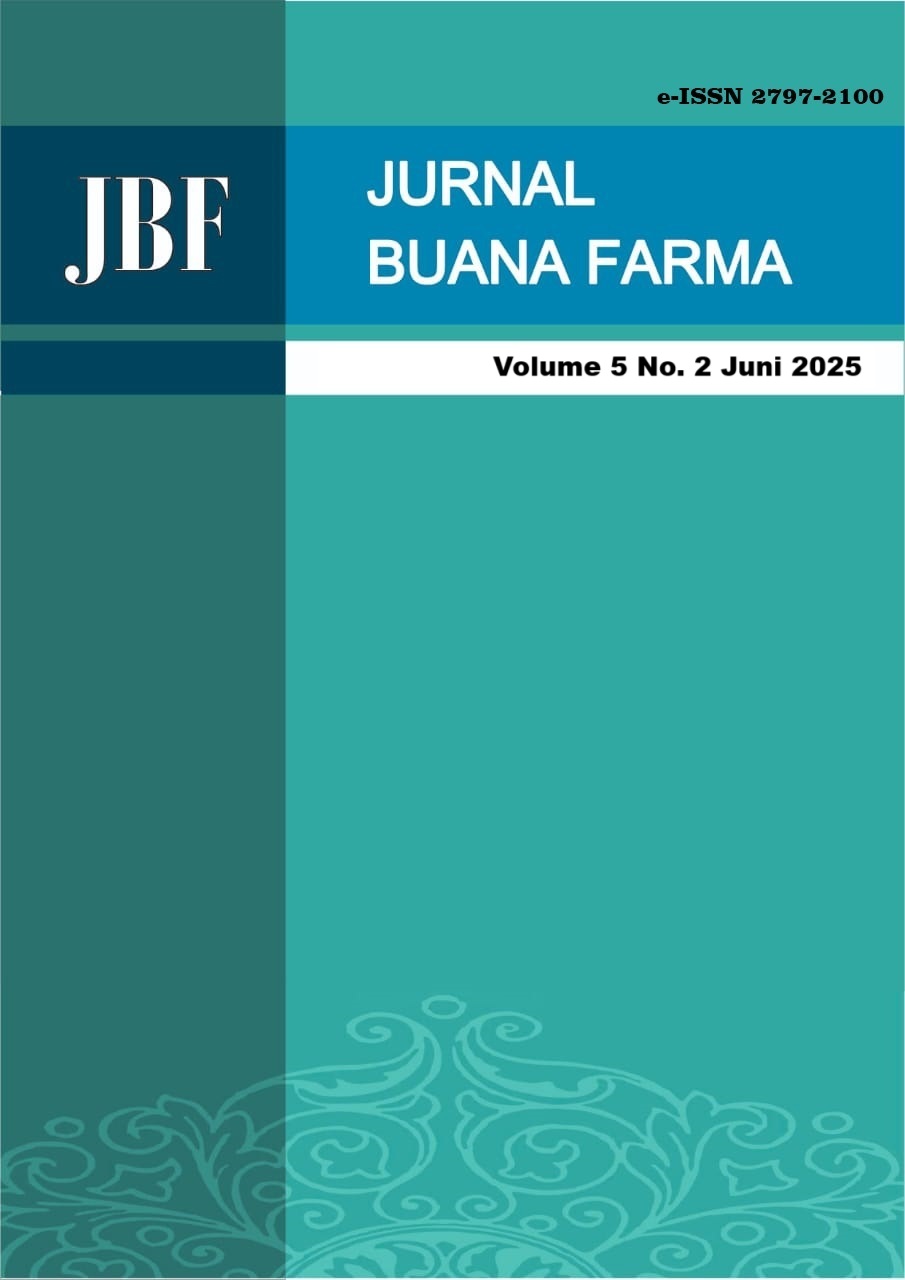UJI ANTIBAKTERI EKSTRAK BATANG GAHARU (Aquilaria malaccensis) BERBASIS KOLIN KLORIDA:ASAM SITRAT TERHADAP Bacillus cereus dan Shigella dysenteriae
Abstrak
Infeksi yang disebabkan oleh Bacillus cereus dan Shigella dysenteriae merupakan masalah kesehatan serius karena dapat menyebabkan gangguan saluran pencernaan serta meningkatkan risiko resistensi antibiotik. Pendekatan yang dilakukan untuk mengatasi masalah ini adalah dengan mengembangkan agen antibakteri baru berbasis bahan alam, seperti tanaman gaharu (Aquilaria malaccensis). Penelitian ini bertujuan untuk mengevaluasi aktivitas antibakteri ekstrak batang gaharu yang diperoleh menggunakan Natural Deep Eutectic Solvent (NADES) berbahan dasar kolin klorida dan asam sitrat melalui metode Ultrasound Assisted Extraction (UAE). Uji antibakteri dilakukan dengan metode difusi cakram menggunakan berbagai rasio NADES (1:1, 2:1, 1:2, 1:3, 1:4, dan 4:1 g/g), dengan kloramfenikol sebagai kontrol positif dan DMSO 10% sebagai kontrol negatif. Hasil menunjukkan bahwa rasio NADES 1:4 g/g menghasilkan zona hambat terbesar terhadap pertumbuhan Bacillus cereus dan Shigella dysenteriae. Selain itu, uji Konsentrasi Hambat Minimum (KHM) menunjukkan bahwa ekstrak dengan rasio NADES 1:4 mampu menghambat pertumbuhan kedua bakteri pada konsentrasi 30%. Temuan ini mengindikasikan bahwa ekstrak batang gaharu dengan pelarut NADES berpotensi sebagai agen antibakteri yang efektif dan ramah lingkungan.
Referensi
Abd Rashed, A., Jamilan, M. A., Abdul Rahman, S., Amin Nordin, F. D., & Mohd Nawi, M. N. (2024). The Therapeutic Potential of Agarwood as an Antimicrobial and Anti-Inflammatory Agent: A Scoping Review. Antibiotics, 13(11), 1074. https://doi.org/10.3390/antibiotics13111074
Acosta-Vega, L., Cifuentes, A., Ibáñez, E., & Galeano Garcia, P. (2025). Exploring Natural Deep Eutectic Solvents (NADES) for Enhanced Essential Oil Extraction: Current Insights and Applications. Molecules, 30(2), 284. https://doi.org/10.3390/molecules30020284
Agustina, E., Andiarna, F., Lusiana, N., Purnamasari, R., & Hadi, Moch. I. (2018). Identifikasi Senyawa Aktif dari Ekstrak Daun Jambu Air (Syzygium aqueum) dengan Perbandingan Beberapa Pelarut pada Metode Maserasi. Biotropic : The Journal of Tropical Biology, 2(2), 108–118. https://doi.org/10.29080/biotropic.2018.2.2.108-118
Ali, M. A., Kaium, M. A., Uddin, S. N., Uddin, M. J., Olawuyi, O., Campbell, A. D., Saint-Louis, C. J., & Halim, M. A. (2023). Elucidating the Structure, Dynamics, and Interaction of a Choline Chloride and Citric Acid Based Eutectic System by Spectroscopic and Molecular Modeling Investigations. ACS Omega, 8(41), 38243–38251. https://doi.org/10.1021/acsomega.3c04570
Anastas, P. T., & Warner, J. C. (2000). Green Chemistry: Theory and Practice. Oxford University Press. https://doi.org/10.1093/oso/9780198506980.001.0001
Aqmarina Nasution, A., Siregar, U. J., Miftahudin, & Turjaman, M. (2020). Identification of chemical compounds in agarwood-producing species Aquilaria malaccensis and Gyrinops versteegii. Journal of Forestry Research, 31(4), 1371–1380. https://doi.org/10.1007/s11676-018-00875-9
Aslam, A., Hashmi, M. F., & Okafor, C. N. (2025). Shigellosis.
Balouiri, M., Sadiki, M., & Ibnsouda, S. K. (2016). Methods for in vitro evaluating antimicrobial activity: A review. Journal of Pharmaceutical Analysis, 6(2), 71–79. https://doi.org/10.1016/j.jpha.2015.11.005
Cannavacciuolo, C., Pagliari, S., Frigerio, J., Giustra, C. M., Labra, M., & Campone, L. (2022). Natural Deep Eutectic Solvents (NADESs) Combined with Sustainable Extraction Techniques: A Review of the Green Chemistry Approach in Food Analysis. Foods, 12(1), 56. https://doi.org/10.3390/foods12010056
Carreira-Casais, A., Otero, P., Garcia-Perez, P., Garcia-Oliveira, P., Pereira, A. G., Carpena, M., Soria-Lopez, A., Simal-Gandara, J., & Prieto, M. A. (2021). Benefits and Drawbacks of Ultrasound-Assisted Extraction for the Recovery of Bioactive Compounds from Marine Algae. International Journal of Environmental Research and Public Health, 18(17), 9153. https://doi.org/10.3390/ijerph18179153
Chemat, F., Rombaut, N., Sicaire, A.-G., Meullemiestre, A., Fabiano-Tixier, A.-S., & Abert-Vian, M. (2017). Ultrasound assisted extraction of food and natural products. Mechanisms, techniques, combinations, protocols and applications. A review. Ultrasonics Sonochemistry, 34, 540–560. https://doi.org/10.1016/j.ultsonch.2016.06.035
Cowan, M. M. (1999). Plant Products as Antimicrobial Agents. Clinical Microbiology Reviews, 12(4), 564–582. https://doi.org/10.1128/CMR.12.4.564
Cushnie, T. P. T., & Lamb, A. J. (2011). Recent advances in understanding the antibacterial properties of flavonoids. International Journal of Antimicrobial Agents, 38(2), 99–107. https://doi.org/10.1016/j.ijantimicag.2011.02.014
Dai, Y., van Spronsen, J., Witkamp, G.-J., Verpoorte, R., & Choi, Y. H. (2013). Natural deep eutectic solvents as new potential media for green technology. Analytica Chimica Acta, 766, 61–68. https://doi.org/10.1016/j.aca.2012.12.019
Duan, L., Dou, L.-L., Guo, L., Li, P., & Liu, E.-H. (2016). Comprehensive Evaluation of Deep Eutectic Solvents in Extraction of Bioactive Natural Products. ACS Sustainable Chemistry & Engineering, 4(4), 2405–2411. https://doi.org/10.1021/acssuschemeng.6b00091
Eissa, M. A., Hashim, Y. Z. H.-Y., Abdul Azziz, S. S. S., Salleh, H. Mohd., Isa, M. L. Md., Abd Warif, N. M., Abdullah, F., Ramadan, E., & El-Kersh, D. M. (2022). Phytochemical Constituents of Aquilaria malaccensis Leaf Extract and Their Anti-Inflammatory Activity against LPS/IFN-γ-Stimulated RAW 264.7 Cell Line. ACS Omega, 7(18), 15637–15646. https://doi.org/10.1021/acsomega.2c00439
García-Roldán, A., Piriou, L., & Jauregi, P. (2023). Natural deep eutectic solvents as a green extraction of polyphenols from spent coffee ground with enhanced bioactivities. Frontiers in Plant Science, 13. https://doi.org/10.3389/fpls.2022.1072592
Gawali, V., Vikas, G. B., Mahesh, B., Nilam, D. B., Yogita, T. S., & Gawali Vikas, C. B. (2018). Development and evaluation of polyhebral powder formulation as energy booster. Journal of Pharmacognosy and Phytochemistry, 7(3). https://www.researchgate.net/publication/338188915
Grozdanova, T., Trusheva, B., Alipieva, K., Popova, M., Dimitrova, L., Najdenski, H., Zaharieva, M. M., Ilieva, Y., Vasileva, B., Miloshev, G., Georgieva, M., & Bankova, V. (2020). Extracts of medicinal plants with natural deep eutectic solvents: enhanced antimicrobial activity and low genotoxicity. BMC Chemistry, 14(1), 73. https://doi.org/10.1186/s13065-020-00726-x
Hasan, N., Rachmayanti, A. S., & Masaenah, E. (2022). Antibacterial activity test of meniran herb extract (Phyllanthus Niruri L.) against staphylococcus epidermidis and klebsiella pneumoniae. In Science Midwifery (Vol. 10, Issue 5). Online. www.midwifery.iocspublisher.orgJournalhomepage:www.midwifery.iocspublisher.org
Hayyan, M., Mbous, Y. P., Looi, C. Y., Wong, W. F., Hayyan, A., Salleh, Z., & Mohd-Ali, O. (2016). Natural deep eutectic solvents: cytotoxic profile. SpringerPlus, 5(1), 913. https://doi.org/10.1186/s40064-016-2575-9
Indrayanto, G. (2022). The importance of method validation in herbal drug research. Journal of Pharmaceutical and Biomedical Analysis, 214, 114735. https://doi.org/10.1016/j.jpba.2022.114735
Jauregi, P., Esnal-Yeregi, L., & Labidi, J. (2024). Natural deep eutectic solvents (NADES) for the extraction of bioactives: emerging opportunities in biorefinery applications. PeerJ Analytical Chemistry, 6, e32. https://doi.org/10.7717/peerj-achem.32
Kotloff, K. L., Platts-Mills, J. A., Nasrin, D., Roose, A., Blackwelder, W. C., & Levine, M. M. (2017). Global burden of diarrheal diseases among children in developing countries: Incidence, etiology, and insights from new molecular diagnostic techniques. Vaccine, 35(49), 6783–6789. https://doi.org/10.1016/j.vaccine.2017.07.036
Lavilla, I., & Bendicho, C. (2017). Fundamentals of Ultrasound-Assisted Extraction. In Water Extraction of Bioactive Compounds: From Plants to Drug Development. Elsevier Inc. https://doi.org/10.1016/B978-0-12-809380-1.00011-5
Matuschek, E., Brown, D. F. J., & Kahlmeter, G. (2014). Development of the EUCAST disk diffusion antimicrobial susceptibility testing method and its implementation in routine microbiology laboratories. Clinical Microbiology and Infection, 20(4), O255–O266. https://doi.org/10.1111/1469-0691.12373
McDowell, R. H., Sands, E. M., & Friedman, H. (2025). Bacillus Cereus. In StatPearls. StatPearls Publishing. http://www.ncbi.nlm.nih.gov/pubmed/30497598
Ministry of Health Republic Indonesia. (2017). Farmakope Herbal Indonesia (II). Ministry of Health Republic Indonesia.
Misrahanum, M., Zahira, A. D., & Saidi, N. (2022). Uji Aktivitas Antibakteri Ekstrak Etanol Daun Gaharu (Aquilaria Malaccensis Lamk.) Dan Identifikasi Senyawa Dengan Metode GC-MS. Jurnal Pharmascience, 9(2), 310–318. https://ppjp.ulm.ac.id/journal/index.php/pharmascience
Nazzaro, F., Fratianni, F., De Martino, L., Coppola, R., & De Feo, V. (2013). Effect of Essential Oils on Pathogenic Bacteria. Pharmaceuticals, 6(12), 1451–1474. https://doi.org/10.3390/ph6121451
Paiva, A., Craveiro, R., Aroso, I., Martins, M., Reis, R. L., & Duarte, A. R. C. (2014). Natural Deep Eutectic Solvents – Solvents for the 21st Century. ACS Sustainable Chemistry & Engineering, 2(5), 1063–1071. https://doi.org/10.1021/sc500096j
Rahman, M. K., Fachriyah, E., & Kusrini, D. (2023). Ekstraksi Daun Salam Berbasis Natural Deep Eutectic Solvent dan Pemanfaatannya sebagai Antioksidan. Greensphere: Journal of Environmental Chemistry, 2(2), 7–12. https://doi.org/10.14710/gjec.2022.16569
World Health Organization. (2020). Antimicrobial resistance. https://www.who.int/news-room/fact-sheets/detail/antimicrobial-resistance. https://www.who.int/news-room/fact-sheets/detail/antimicrobial-resistance
World Health Organization. (2022). Global Antimicrobial Resistance Surveillance System (GLASS) Report 2022.
Zhang, J.-H., Chung, T. D. Y., & Oldenburg, K. R. (1999). A Simple Statistical Parameter for Use in Evaluation and Validation of High Throughput Screening Assays. SLAS Discovery, 4(2), 67–73. https://doi.org/10.1177/108705719900400206













